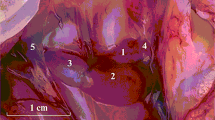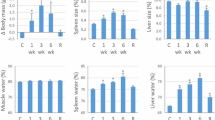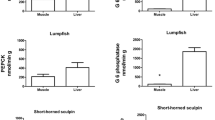Summary
Carbohydrate metabolism of the sea cucumber,Sclerodactyla briareus, was investigated in an effort to find metabolic pathways that might be useful during exposure to hypoxic conditions. The utilization of glucose-U-14C by in vitro longitudinal muscle preparations was not enhanced during exposure to reduced oxygen tensions. Alanine was the most highly labelled compound regardless of incubation conditions. Hypoxic exposure resulted in a four-fold increase in radioactivity in lactate, and decreased radioactivity in alanine, glutamate and aspartate. Succinate and volatile acids were not observed to be significant end products of anaerobic glycolysis inS. briareus longitudinal muscle. The relative activities of a number of glycolytic and gluconeogenic enzymes in longitudinal muscle were consistent with the observations of isotope distribution. Levels of lactate in muscle tissue of sea cucumbers exposed to 24 and 48 h of hypoxia were on the average 20 times higher than the values for aerobic controls. The kinetic characteristics of longitudinal muscle lactate dehydrogenase coupled with hypoxic acid release and the lack of an oxygen debt phenomenon by in vitro longitudinal muscle preparations indicate that lactate may not be appreciably oxidized in this tissue but is released into the body fluids. Unlike many anoxia-tolerant invertebrates which produce primarily succinate during exposure to reduced oxygen tensions, specimens ofSclerodactyla briareus produce lactate as a major glycolytic end product.
Similar content being viewed by others
Abbreviations
- AAT:
-
alanine aminotransferase
- ADP:
-
adenosine-5′-diphosphate
- DHAP:
-
dihydroxyacetone phosphate
- IDP:
-
inosine-5′-diphosphate
- LDH:
-
lactate dehydrogenase
- MDH:
-
malate dehydrogenase
- NAD:
-
nicotinamide adenine dinucleotide
- NADP:
-
nicotinamide adenine dinucleotide phosphate
- PEPCK:
-
phosphoenolpyruvate carboxykinase
- PK:
-
pyruvate kinase
References
Barker, S.B., Summerson, W.H.: The colorimetric determination of lactic acid in biological material. J. biol. Chem.138, 534–554 (1941)
Barnes, H., Finlayson, D.M., Piatigorsky, J.: The effect of desiccation and anaerobic conditions on the behavior, survival and general metabolism of three common cirrepedes. J. Anim. Ecol.32, 233–252 (1963)
Boyland, E.: Chemical changes in muscle. II. Invertebrate muscle. Biochem. J.22, 362–376 (1928)
Brand, T. v., Baernstein, H.D., Mehlman, B.: Studies on the anaerobic metabolism and the aerobic carbohydrate content of some fresh water snails. Biol. Bull.98, 266–276 (1950)
Buddington, R.A.: The normal spontaneity of movement of the respiratory muscles ofThyone briareus Leseur. Physiol. Zool.10, 141–155 (1937)
Chen, C., Awapara, J.: Intracellular distribution of enzymes catalyzing succinate production from glucose inRangia mantle. Comp. Biochem. Physiol.30, 727–737 (1969a)
Chen, C., Awapara, J.: Effect of oxygen on the end products of glycolysis inRangia cuneata. Comp. Biochem. Physiol.31, 395–401 (1969b)
Cleland, K.W., Lord Rothschild: The metabolism of the sea urchin egg. Anaerobic breakdown of carbohydrate. J. exp. Biol.29, 285–294 (1952)
Dales, R.P.: Survival of anaerobic periods by two intertidal polychaetesArenicola marina andOwenia fusiformis Delle Chiaje. J. mar. biol. Assoc. U.K.37, 521–529 (1958)
Dubois, M., Gilles, K.A., Ng, Y.C., Nichols, A.V.: Colorimetric method for the determination of sugars and related substances. Analyt. Chem.28, 350–356 (1956)
Dunnington, E.A.: Survival time of oysters after burial at various temperatures. Proc. Nat. Shellfish Assoc.58, 101–103 (1968)
Ellington, W.R.: Holothurian facultative anaerobiosis. Amer. Zool.15, 808 (1975)
Ellington, W.R.: L-Lactate dehydrogenase in the longitudinal muscle of the sea cucumber,Sclerodactyla briareus (Echinodermata: Holothuroidea). Mar. Biol.36, 31–36 (1976)
Gäde, G.: Anaerobic metabolism in the common cockle,Cardium edule. I. The utilization of glycogen and accumulation of multiple end products. Arch. Int. Physiol. Biochem.83, 879–886 (1975)
Gäde, G., Wilps, H.: Glycogen degradation and end products of anaerobic metabolism in the freshwater bivalveAnodonta cygnea. J. comp. Physiol.104, 74–85 (1975)
Garber, A.J., Karl, I.E., Kipnis, D.M.: Alanine and glutamine synthesis and release from skeletal muscle. J. biol. Chem.251, 826–835 (1976)
Gay, W.S., Simon, S.E.: Metabolic control in holothuroidean muscle. Comp. Biochem. Physiol.11, 183–192 (1964)
Goforth, H.W.: Metabolic end products of the American oyster,Crassostrea virginica (Gmelin). M.A. Thesis, University of South Florida, Tampa 1974
Hammen, C.S.: Metabolism of the oyster,Crassostrea virginica. Amer. Zool.9, 309–318 (1969)
Hammen, C.S.: Respiratory adaptations: Invertebrates. Proc. Third Int. Estuarine Res. Symp. (ed. M.L. Wiley) New York: Academic Press 1977
Hammen, C.S., Osborne, B.J.: Carbon dioxide fixation in marine invertebrates: A survey of major phyla. Science130:1409–1410 (1959)
Hochachka, P.W., Fields, J., Mustafa, T.: Animal life without oxygen: Basic biochemical mechanisms. Amer. Zool.13, 543–555 (1973)
Hochachka, P.W., Storey, K.B.: Metabolic consequences of diving in animals and man. Science187, 613–621 (1975)
Hohorst, H.J., Arese, P., Bartels, H., Stratman, D., Talke, H.: L(+) Lactic acid and the steady state of cellular RED/OX systems. Ann. N.Y. Acad. Sci.119, 974–994 (1965)
Kluytmans, J.H., Veenhof, P.R., de Zwaan, A.: Anaerobic production of volatile fatty acids in the sea musselMytilus edulis L. J. comp. Physiol.104, 71–78 (1975)
Mangum, C.P.: Evaluation of the functional properties of invertebrate hemoglobins. Neth. J. Sea Res.7, 303–315 (1973)
Mangum, C.P., van Winkle, W.: Responses of aquatic invertebrates to declining oxygen tensions. Amer. Zool.13, 529–541 (1973)
McManus, D.P., James, B.L.: Anaerobic glucose metabolism in the digestive gland ofLittorina saxatilis rudis (Maton) and in the daughter sporocysts ofMicrophallus similis (Jäg) (Digenea: Microphallidae). Comp. Biochem. Physiol.51B, 293–297 (1975)
Mehlman, B., Brand, T. v.: Further studies on the anaerobic metabolism of some fresh water snails. Biol. Bull.100, 199–205 (1951)
Monroy, A., Vittorelli, M.L.: Utilization of14C-glucose for amino acid and protein synthesis by the sea urchin embryo. J. cell. comp. Physiol.60, 285–287 (1962)
Odessey, R., Khairallah, E.A., Goldberg, A.L.: Origin and possible significance of alanine production by skeletal muscle. J. biol. Chem.249, 7623–7629 (1974)
Sassaman, C., Mangum, C.P.: Relationship between aerobic and anaerobic metabolism in estuarine anemones. Comp. Biochem. Physiol.44A, 1313–1319 (1973)
Stokes, T.M., Awapara, J.: Alanine and succinate as end products of glucose degradation in the clam,Rangia cuneata. Comp. Biochem. Physiol.25, 883–882 (1968)
Theede, H.: Comparative studies on the influence of oxygen deficiency and hydrogen sulphide on bottom marine invertebrates. Neth. J. Sea Res.7, 244–252 (1973)
Williamson, D.H., Lopes-Vieira, O., Walker, B.: Concentratioms of free glucogenic amino acids in livers of rats subjected to various metabolic stresses. Biochem. J.104, 497–502 (1967)
Zebe, E.: In vivo Untersuchungen über die Glucose-Abbau beiArenicola marina (Annelida, Polychaeta). J. comp. Physiol.101, 133–145 (1975)
Zwaan, A. de, Bont, A.M.T. de, Kluytmans, J.H.: Metabolic adaptations on the aerobic-anaerobic transition in the sea musselMytilus edulis (L). Proc. 9th Europ. mar. biol. Symp. 121–138 (1975)
Zwaan, A. de, Zandee, D.I.: The utilization of glycogen and accumulation of some intermediates during anaerobiosis inMytilus edulis L. Comp. Biochem. Physiol.43B, 47–54 (1972)
Author information
Authors and Affiliations
Additional information
A brief account of some of this work was published inAmerican Zoologist 15, 808 (1975). This work is derived from portions of a dissertation submitted to the University of Rhode Island by the senior author in partial fulfillment of the degree of Doctor of Philosophy. Partial support of this research was provided by a Society of the Sigma Xi Grant-in-Aid for Research
Rights and permissions
About this article
Cite this article
Ross Ellington, W., Hammen, C.S. Metabolic compensation to reduced oxygen tensions in the sea cucumber,Sclerodactyla briareus (Leseur). J Comp Physiol B 122, 347–358 (1977). https://doi.org/10.1007/BF00692520
Received:
Issue Date:
DOI: https://doi.org/10.1007/BF00692520




